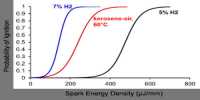The correlation applied to gasoline and to kerosene:
106 k/cal s-1 cm-1 °C-1 = 333 — 0.19t
at 20°C and at distillation temperatures will in our coverage of diesel be applied for negative values of t, that is, temperatures below 0°C. At temperatures in the region of the cloud point, say -10°C, the prediction of the correlation is:
k = 335 x 10-6 cal s-1 cm-1 K-1 ≡ 0.14 W m-1 k-1
so this property is not significantly affected by the low temperature at aircraft cruising altitudes. The thermal conductivity is of course relevant even where heat transfer is by convection, as at aircraft speeds it is likely to be. This is because in convective heat transfer there is conduction across the thermal boundary layer. That is why the thermal conductivity of the fluid appears in the denominator of the Nusselt number, the dimensionless form of the heat transfer coefficient which in forced convection depends on the degree of turbulence expressible as the Reynolds number.
A significant proportion of the vehicles on the highways of the world use diesel engines. A generation ago there was some suspicion as to their reliability and, to reduce the discussion to a mildly materialistic level, concern that a diesel car purchased new would not a few years later attract a good trade-in price.












